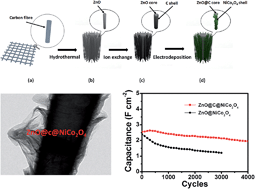Metal–organic-framework-derived ZnO@C@NiCo2O4 core–shell structures as an advanced electrode for high-performance supercapacitors†
Abstract
Tremendous attention has been paid to the rational design and synthesis of unique core–shell nanostructures for high-performance supercapacitors. In this work, unique core–shell ZnO@C@NiCo2O4 nanorod sheet arrays (NRSAs) on a carbon cloth substrate were synthesized through a facile hydrothermal and electrodeposition method. Benefiting from the introduction of carbon derived from metal–organic frameworks (MOFs) and the core–shell structure, the hybrid electrode exhibited a significantly enhanced electrochemical performance compared to ZnO@NiCo2O4 nanorod sheet arrays (NRSAs) without a carbon matrix. The ZnO@C@NiCo2O4 NRSA electrode delivered a high areal capacitance (3.18 F cm−2 at 6 mA cm−2) (2650 F g−1 at 5 A g−1), good rate capability and cycling stability (76% capacitance retention after 4000 cycles at a high current density of 10 mA cm−2). With excellent electrochemical performance and a facile and cost-effective synthesis, such ZnO@C@NiCo2O4 NRSA electrodes hold great promise for high-performance supercapacitor applications in future.


 Please wait while we load your content...
Please wait while we load your content...